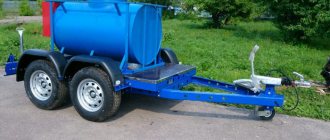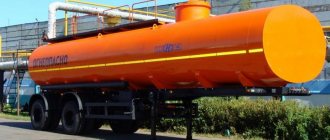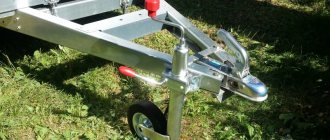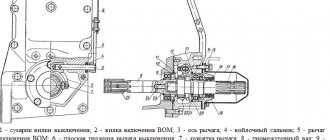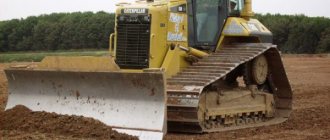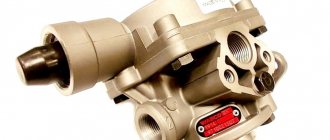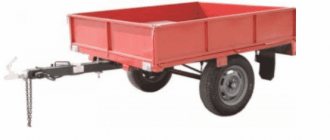HomePlant products Automotive special equipment
The Becema Engineering Plant offers a wide range of food tank trucks for transporting alcohol and alcohol-containing liquids, wine materials and milk (milk tankers). Our clients include both large manufacturers and small enterprises. The nominal useful capacity of BCM food tanks ranges from 32,000 to 1,000 liters, which allows each customer to choose the equipment that is optimal in terms of volume and functionality.
| Tank semi-trailer for food liquids BCM-42.3 |
| Tank truck for food liquids BCM-138 |
| Tank truck for food liquids BCM-139 |
| Tank semi-trailer for food liquids BCM-140 |
| Tank semi-trailer for food liquids BCM-145 |
| Tank truck for food liquids BCM-226 |
| Tank truck for food liquids BCM-227 |
Food tanker trucks design features
There are installations on a car chassis, as well as in the form of a trailer or semi-trailer.
Food tanks come in single and multiple sections (usually two sections). The cross section of a barrel is usually an ellipse. This shape is due to a decrease in the center of gravity due to flatness, which eliminates the appearance of roll when a fully loaded vehicle moves in turns.
It is located horizontally along the frame and has two flat bottoms. Partitions - breakwaters - are installed inside to reduce the impact of liquid on the walls of the container. They have round holes for smooth flow of liquid between the compartments. There is a neck on top for pouring the product, which is securely closed with an airtight lid. There is a drain fitting at the bottom to empty the contents.
The body of food tanks for transporting milk is made of stainless steel. Thanks to alloying elements, the material does not interact with the load and almost completely eliminates the occurrence of intergranular corrosion. The barrel is covered with special isothermal materials that allow the set internal temperature to be maintained for a long time, which directly affects the shelf life of the food liquid.
Bodies are either load-bearing or frame:
- Load-bearing is when the structure itself carries a supporting load, being a strong frame on which the cladding is hung. Typically, such tanks are installed on light vehicles.
- The vast majority are framed. Here the barrel rests on the supports of a strong frame, which carries the strength load and is the connecting link between the body and the suspension. To increase the strength and rigidity of the body, the barrel shell in the area of the cradle is surrounded by a bandage.
Recently, tank trailers have become increasingly common. It is attached to the tow bar of the tractor, or to the fifth wheel in the case of a semi-trailer. The use of these transport containers increases the volume of one-time delivery of milk and thereby makes transportation more rational.
Filling and draining equipment
The tank is filled either through filler necks or through pipelines. They have a special coating to prevent freezing, as well as heating. Many machines are additionally equipped with a filling/draining pump station, to which the lines are connected.
Emptying occurs by gravity or using a pumping device under pressure. The approximate capacity of tanker pumps is 20 - 30 cubic meters. m/hour.
They have several operating modes:
- filling containers;
- supplying the product from the container;
- pumping using a pump without filling the barrel.
The pump is powered by the car engine. When the liquid level reaches the upper limit, the limit switch is triggered, the alarm is activated and the supply is stopped.
The pipelines use quick-release couplings to quickly carry out filling or draining operations.
Milk is transported to a processing plant or milk collection points in tanks and flasks approved by the Ministry of Health for contact with food by all modes of transport in accordance with the rules for the transportation of perishable goods in force for this type of transport.
Milk is transported in special tankers. In hot weather it does not heat up, and in winter it does not freeze. When transported over a distance of 100 km in summer, the temperature of milk increases by 1-2°C. Milk losses when transported in tank trucks are 0.023%, when transported in flasks - 0.34%, or 10 times or more. It has been established that transporting milk by road tanks (capacity from 2 to 10 tons or more), as well as by rail (20-30 tons) is the most rational, as it helps preserve all its properties. It is advisable to use the circular route.
Milk tankers designed for transporting milk are made of sheet aluminum and stainless steel and consist of one, two or four sections. To prevent the milk from heating up during transportation, the outer surface of the tank is covered with thermal insulation material and lined with a casing made of thin steel sheet. Each section of the molten tank is equipped with a hatch that is hermetically sealed with a lid using a sealing ring rubber gasket. The tank is filled with milk under vacuum, and it is better to fill it from the bottom to avoid foaming of the milk. Each section of the tank is filled with milk of the same quality.
Monitoring the filling of the tank with milk is carried out using an electrical alarm system: in the upper part of the tank there are sensors for the upper level of milk to signal that the section is filled with milk. Before being sent to a milk processing plant, the tanks are sealed. When receiving milk from the milk tank at the factory, milk is drained by gravity or using a factory pump.
Small farms deliver milk in flasks to the processing plant. This type of container is inconvenient because due to its small capacity in the warm season, milk quickly heats up and sours on the way, and in winter it can freeze. Before transportation, the milk is mixed, the flasks are closed with lids with gaskets made of “food grade” rubber (replacing them with other materials is prohibited) and sealed. They must be filled completely to prevent the settled cream from churning into the butter. In winter, during frosts, the flasks are underfilled by 1-2 liters, so that if the milk freezes, the flask does not burst.
It is necessary to transport milk in flasks during cool times of the day - in the morning or evening. In hot weather, milk flasks are covered with a wet tarpaulin to keep the milk warm during transit.
Transport used for transporting milk and dairy products must be clean and in good condition, the body of the vehicle must have a hygienic coating that can be easily washed. It is not allowed to transport milk together with strong-smelling, dusty and toxic substances (gasoline, kerosene, tar, toxic chemicals, cement, chalk), as well as the use of milk tanks and flasks for transporting other substances.
Milk is transported by rail. Flasks of milk are transported in isothermal wagons at a temperature of 3-5°C. Isothermal railway milk tanks are more often used. Sometimes milk is transported in tanks that are placed on a railway platform.
Water transport is used to transport milk. When transporting milk, special boats equipped with refrigeration units are used.
It is possible to transport milk using polyethylene pipes. In recent years, polyethylene pipes have been used to transport milk, especially from mountain pastures (gravity milk pipelines) and in places where farms are close to dairies. This method of transporting milk is the most appropriate and has great prospects.
Milk tankers
The milk tank is designed for transporting the product to various distances, as well as for its temporary storage. The properties of milk are preserved due to the use of temperature control equipment inside the body in the design.
Welded seams of containers are made with the removal of reinforcement and high-quality cleaning, so that milk residues do not accumulate within the usable volume. In addition, there is a slight slope towards the drain neck.
Most containers have a special coating applied on the inside. These measures were taken to ensure that the entire contents of the tank went down the drain, because filling a new batch and mixing it with sour residues would spoil the entire transported product. The outside of the unit is equipped with podiums and handrails to facilitate maintenance of the body and equipment.
The machines also use integrated temperature control systems, because at low temperatures the shelf life of the product increases significantly. Polystyrene foam is used as body insulation. The thickness of the insulating layer of this material is 40 – 80 mm.
When working in sub-zero temperatures, milk must be heated. It is carried out by a thermal electric heater of a three-circuit design. Milk tankers are equipped with special slats for cleaning and washing.
Milk tankers produced by the Becema plant are equipped with
- flow meters with data display;
- DN50 with shut-off valves on each compartment at the top of the tank;
- pneumatically controlled butterfly valves in each compartment;
- thermally insulated hatches heated by autonomous heater air ducts.
Thanks to effective thermal insulation technologies, the milk tanker is able to ensure the safety of the transported product for a long time. The maximum permissible increase in cargo temperature is no more than 2°C in 10 hours at a temperature difference between the liquid and the environment of 30°C.
Milk tanker modifications
Milk tankers are produced on the basis of all existing basic trucks, as well as many trailers and semi-trailers.
Among the light series, we can highlight the Gazelle milk tanker GAZ 3302. A single-section barrel with an internal volume of 1250 liters is installed on the chassis.
The next largest is the GAZ-3309. This is a medium-tonnage two-section tank with a volume of 4100 liters.
Heavy series - KamAZ-65115. A 9,800 liter milk tanker with a three-section design is produced on a three-axle truck chassis.
Based on the MAZ-6312 truck, a tank is produced for transporting as many as 14 cubic meters of liquid dairy products, which is made with 1-3 compartments.
Milk semi-trailers, which operate in conjunction with truck tractors, boast the largest volumes. The volume of this type of barrel reaches 20 - 30 cubic meters.
Among the trailers, SAZ-83172-08 produced by the Saransk Automobile Plant with a container volume of 1800 liters should be highlighted. It is designed to work with GAZ 3302.
For KamAZ vehicles, a milk tank trailer G6-OPA-8.1/3 is used - a three-section barrel with a capacity of 8.1 cubic meters.
Cargo Features
Milk tankers are designed for year-round use. The inside of their tanks is maintained at the optimal temperature for transporting food. To do this, they are equipped with the following elements:
- thick layer of insulation;
- heating elements;
- coolers.
Inside a new and fully operational milk tanker, the liquid maintains its temperature for 10 hours. Thanks to this, the product can be delivered to remote parts of the region, preserving all its beneficial properties and taste characteristics.
How much can you buy food tanks for?
Light series trailers cost approximately 300,000 - 400,000 rubles, medium ones - over half a million. Heavy trailers cost more than a million rubles.
The price of tank semi-trailers starts from 2.5 million rubles without coolers and over three with a cooler.
The price of GAZ-3302 is approximately 1,100,000 rubles, GAZ-3309 is from 1,700,000, KamAZ-4325 is 3,500,000, KamAZ-65115 is from 4 million.
Reviews
Reviews of food tankers depend primarily on the expected consumer qualities, class and requirements.
For large companies and dairies, volumes are important, but at the same time, single medium-tonnage trucks are used for urban transportation, and road trains with semi-trailers are used for regional and international transportation. Here the price fades into the background, and the quality of the equipment takes priority in order to preserve the transported product for as long as possible.
There are very good reviews in this regard about KamAZ 4325. Its barrel has an optimal volume of 9 cubic meters. When using the vehicle for regional transportation, a trailer with a volume of 8.1 cubic meters is attached to it.
At the same time, the two-axle chassis, combined with an economical engine, has the highest fuel and economic indicators, which makes transportation by these tank trucks quickly pay for itself.
Private owners would rather prefer the GAZ-3309 or GAZ-3302. They are distinguished by their simplicity of design, cheap and always available spare parts, and low labor intensity of maintenance and repair. The containers themselves have small volumes, which is optimal for farmers and small local factories.
